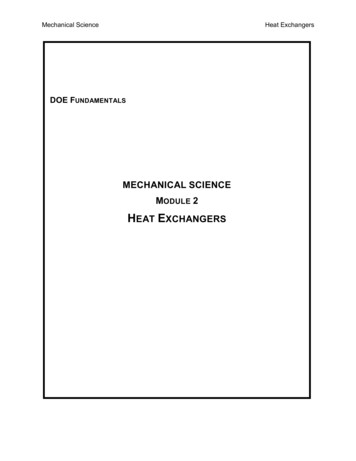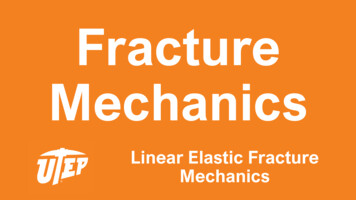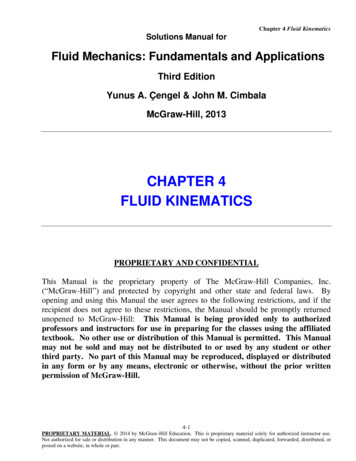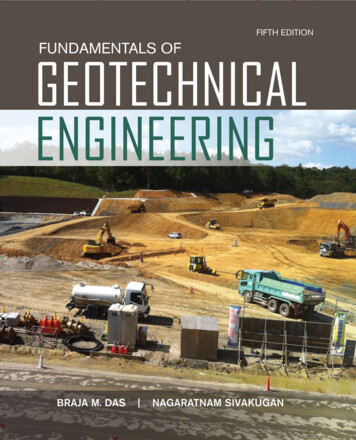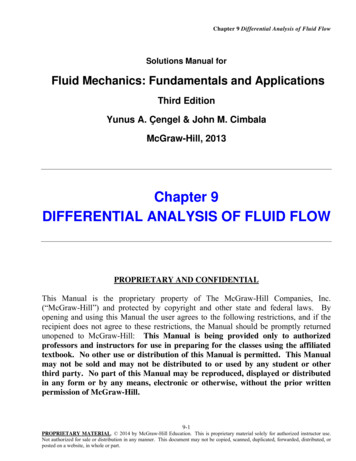
Transcription
Chapter 9 Differential Analysis of Fluid FlowSolutions Manual forFluid Mechanics: Fundamentals and ApplicationsThird EditionYunus A. Çengel & John M. CimbalaMcGraw-Hill, 2013Chapter 9DIFFERENTIAL ANALYSIS OF FLUID FLOWPROPRIETARY AND CONFIDENTIALThis Manual is the proprietary property of The McGraw-Hill Companies, Inc.(“McGraw-Hill”) and protected by copyright and other state and federal laws. Byopening and using this Manual the user agrees to the following restrictions, and if therecipient does not agree to these restrictions, the Manual should be promptly returnedunopened to McGraw-Hill: This Manual is being provided only to authorizedprofessors and instructors for use in preparing for the classes using the affiliatedtextbook. No other use or distribution of this Manual is permitted. This Manualmay not be sold and may not be distributed to or used by any student or otherthird party. No part of this Manual may be reproduced, displayed or distributedin any form or by any means, electronic or otherwise, without the prior writtenpermission of McGraw-Hill.9-1PROPRIETARY MATERIAL. 2014 by McGraw-Hill Education. This is proprietary material solely for authorized instructor use.Not authorized for sale or distribution in any manner. This document may not be copied, scanned, duplicated, forwarded, distributed, orposted on a website, in whole or part.
Chapter 9 Differential Analysis of Fluid FlowGeneral and Mathematical Background Problems9-1CSolutionWe are to express the divergence theorem in words. AnalysisFor vector G , the volume integral of the divergence of G over volume V is equal to the surface integral of the normal component of G taken over the surface A that encloses the volume.DiscussionThe divergence theorem is also called Gauss’s theorem.9-2CSolutionWe are to explain the fundamental differences between a flow domain and a control volume.AnalysisA control volume is used in an integral, control volume solution. It is a volume over which all mass flowrates, forces, etc. are specified over the entire control surface of the control volume. In a control volume analysis we do notknow or care about details inside the control volume. Rather, we solve for gross features of the flow such as net force actingon a body. A flow domain, on the other hand, is also a volume, but is used in a differential analysis. Differentialequations of motion are solved everywhere inside the flow domain, and we are interested in all the details inside the flowdomain.DiscussionNote that we also need to specify what is happening at the boundaries of a flow domain – these are calledboundary conditions.9-3CSolutionWe are to explain what we mean by coupled differential equations.AnalysisA set of coupled differential equations simply means that the equations are dependent on each other andmust be solved together rather than separately. For example, the equations of motion for fluid flow involve velocityvariables in both the conservation of mass equation and the momentum equation. To solve for these variables, we mustsolve the coupled set of differential equations together.DiscussionIn some very simple fluid flow problems, the equations become uncoupled, and are easier to solve.9-4CSolutionWe are to discuss the number of unknowns and the equations needed to solve for those unknowns for athree-dimensional, unsteady, incompressible flow field.Analysisequations: There are four unknowns (velocity components u, v, w, and pressure P) and thus we need to solve fourone from conservation of mass which is a scalar equationthree from Newton’s second law which is a vector equationDiscussionThese equations are also coupled in general.9-2PROPRIETARY MATERIAL. 2014 by McGraw-Hill Education. This is proprietary material solely for authorized instructor use.Not authorized for sale or distribution in any manner. This document may not be copied, scanned, duplicated, forwarded, distributed, orposted on a website, in whole or part.
Chapter 9 Differential Analysis of Fluid Flow9-5CSolutionWe are to discuss the number of unknowns and the equations needed to solve for those unknowns for a twodimensional, unsteady, compressible flow field with significant variations in both temperature and density.Analysisequations: There are five unknowns (velocity components u and v, and , T, and P) and thus we need to solve fiveone from conservation of mass which is a scalar equationtwo from Newton’s second law which is a vector equationone from the energy equation which is a scalar equationone from an equation of state (e.g., ideal gas law) which is a scalar equationDiscussionThese equations are also coupled in general.9-6CSolutionWe are to discuss the number of unknowns and the equations needed to solve for those unknowns for a twodimensional, unsteady, incompressible flow field.Analysisequations: There are three unknowns (velocity components u, and v, and pressure P) and thus we need to solve threeone from conservation of mass which is a scalar equationtwo from Newton’s second law which is a vector equationDiscussionThese equations are also coupled in general.9-7SolutionWe are to transform a position from Cartesian to cylindrical coordinates.AnalysisWe use the coordinate transformations provided in this chapter,r x 2 y 2 (2 m) 2 (4 m) 2 4.47214 m(1)and tan 1y 4m tan 1 63.43495 1.10715 radiansx 2m Coordinate z remains unchanged. Thus, to three significant digits, Position in cylindrical coordinates:x (r , , z ) (4.47 m, 1.11radians, 1 m)Discussion(2)(3)Notice that the units of are radians – a dimensionless unit.9-3PROPRIETARY MATERIAL. 2014 by McGraw-Hill Education. This is proprietary material solely for authorized instructor use.Not authorized for sale or distribution in any manner. This document may not be copied, scanned, duplicated, forwarded, distributed, orposted on a website, in whole or part.
Chapter 9 Differential Analysis of Fluid Flow9-8SolutionWe are to transform a position from cylindrical to Cartesian coordinates.AnalysisWe use the coordinate transformations provided in this chapter, x r cos 5 m cos / 3 radians 5 m cos 60o 2.5 m(1)and y r sin 5 m sin / 3 radians 5 m sin 60o 4.33013 mCoordinate z remains unchanged. Thus, to three significant digits, Position in cylindrical coordinates:x x,y,z 2.50 m, 4.33 m, 1.27 m (2)(3)DiscussionYou can verify your answer by using the reverse equations, as in the previous problem.9-9Solutionexact value.We are to calculate a truncated Taylor series expansion for a given function and compare our result with theAnalysisThe algebra here is simple since d(ex)/dx ex. The Taylor series expansion is1 x0 21 x0 3e dx e dx .23 2(1)Truncated Taylor series expansion:11f ( 0.1) 1 1 ( 0.1) 1 ( 0.1) 2 1 ( 0.1)3 0.9048333.26(2)Taylor series expansion:f ( x0 dx) e x0 e x0 dx We plug x0 0 and dx –0.1 into Eq. 1,We compare Eq. 2 with the exact value,f ( 0.1) e 0.1 0.904837418.Exact value:(3)Comparing Eqs. 2 and 3 we see that our approximation is good to four or five significant digits.DiscussionThe smaller the value of dx, the better the approximation. You can easily convince yourself of this by tryingdx 0.01 instead.9-10SolutionAnalysisWe are to calculate the divergence of a given vector. The divergence of G is the dot product of the del operator i j k with G , which gives x y z 1 G i j k 2 xzi x 2 j z 2 k 2 z 0 2 z 0 y z 2 x It turns out that for this special case, the divergence of G is zero. DiscussionIf G were a velocity vector, this would mean that the flow field is incompressible. Divergence of G :9-4PROPRIETARY MATERIAL. 2014 by McGraw-Hill Education. This is proprietary material solely for authorized instructor use.Not authorized for sale or distribution in any manner. This document may not be copied, scanned, duplicated, forwarded, distributed, orposted on a website, in whole or part.
Chapter 9 Differential Analysis of Fluid Flow9-11SolutionWe are to expand the given equation in Cartesian coordinates and verify it. AnalysisIn Cartesian coordinates the del operator is i j k and we let F Fx i Fy j Fz k and x y z G Gx i Gy j Gz k . The left hand side of the equation is thusFx Gz Fy Gz Fz Gz Fx Gx Fy Gx Fz Gx i y z x Fx G y Fy Gy Fz Gy j y z x Fx Gz Fy Gz Fz Gz k y z x FG x Fx Gx Fy Gx z Fz Gx y Fx G yFy GyFz Gy (1) We use the product rule on each term in Eq. 1 and rearrange to getLeft hand side: F Fy Fz FG Gx x Fy Fz Gx i Fx y z x y z x F Fy Fz G y x Fy Fz Gy j Fx y z x y z x F Fy Fz Gz x Fy Fz Gz k Fx y z x y z x We recognize that(2) Fx Fy Fz F and Fx Fy Fz F . Eq. 2 then becomes x y z x y zLeft hand side: FG Gx F F Gx i Gy F F Gy j Gz F F Gz k (3)After rearrangement, Eq. 3 becomesLeft hand side: FG Gx i G y j Gz k F F Gx i G y j Gz k (4) Finally, recognizing vector G twice in Eq. 4, we see that the left hand side of the given equation is identical to the righthand side, and the given equation is verified. DiscussionIt may seem surprising, but FG GF .9-5PROPRIETARY MATERIAL. 2014 by McGraw-Hill Education. This is proprietary material solely for authorized instructor use.Not authorized for sale or distribution in any manner. This document may not be copied, scanned, duplicated, forwarded, distributed, orposted on a website, in whole or part.
Chapter 9 Differential Analysis of Fluid Flow9-12SolutionWe are to prove the equation.Analysis We let F V and G V . Using Eq. 1 of the previous problem, we have VV V V V V (1)However, since the density is not operated on in the second term of Eq. 1, it can be brought outside of the parenthesis, eventhough it is not a constant in general. Equation 1 can thus be written as VV V V V V(2) DiscussionEquation 2 was used in this chapter in the derivation of the alternative form of Cauchy’s equation.9-13SolutionWe are to transform cylindrical velocity components to Cartesian velocity components.Analysisalso ,We apply trigonometry, recognizing that the angle between u and ur is , and the angle between v and u isx component of velocity:u ur cos u sin (1)v ur sin u cos (2)w uz(3)Similarly,y component of velocity:The transformation of the z component is trivial,z component of velocity:DiscussionThese transformations come in handy.9-14SolutionWe are to transform Cartesian velocity components to cylindrical velocity components.Analysisalso ,We apply trigonometry, recognizing that the angle between u and ur is , and the angle between v and u isur component of velocity:ur u cos v sin (1)u u sin v cos (2)uz w(3)Similarly,u component of velocity::The transformation of the z component is trivial,z component of velocity:DiscussionYou can also obtain Eqs. 1 and 2 by solving Eqs. 1 and 2 of the previous problem simultaneously.9-6PROPRIETARY MATERIAL. 2014 by McGraw-Hill Education. This is proprietary material solely for authorized instructor use.Not authorized for sale or distribution in any manner. This document may not be copied, scanned, duplicated, forwarded, distributed, orposted on a website, in whole or part.
Chapter 9 Differential Analysis of Fluid Flow9-15SolutionWe are to transform a given set of Cartesian coordinates and velocity components into cylindricalcoordinates and velocity components.First we apply the coordinate transformations given in this chapter,Analysisr x2 y 2 tan 1 0.40 m 0.20 m 22 0.4472 m(1)y 0.20 m o tan 1 26.565 0.4636 radiansx 0.40 m (2)Next we apply the results of the previous problem,m 0.40 mm 0.20 mm 5.6 6.708s 0.4472 ms 0.4472 ms(3)m 0.20 mm 0.40 mm 5.6 9.615s 0.4472 ms 0.4472 ms(4)ur u cos v sin 10.3u u sin v cos 10.3Note that we have used the fact that x rcos and y rsin for convenience in Eqs. 3 and 4. Our final results aresummarized to three significant digits:r 0.447 m, 0.464 radians, ur 6.71Results:mm, u 9.62ss(5)We verify our result by calculating the square of the speed in both coordinate systems. In Cartesian coordinates,222m m m V 2 u 2 v 2 10.3 5.6 137.5 2s s s (6)In cylindrical coordinates,222m m m V 2 ur 2 u 2 6.708 9.615 137.5 2s s s Discussion(7)Such checks of our algebra are always wise.9-16SolutionWe are to transform a given set of Cartesian velocity components into cylindrical velocity components, andidentify the flow.Assumptions1 The flow is steady. 2 The flow is incompressible. 3 The flow is two-dimensional in the x-y or r- plane.AnalysisWe recognize that r 2 x 2 y 2 . We also know that y rsin and x rcos . Using the results of Problem 914, the cylindrical velocity components areur component of velocity:u component of velocity::ur u cos v sin Cr sin cos Cr sin cos 0r2r2u u sin v cos Cr sin 2 Cr cos 2 C rr2r2(1)(2)where we have also used the fact that cos2 sin2 1. We recognize the velocity components of Eqs. 1 and 2 as those of aline vortex.DiscussionThe negative sign in Eq. 2 indicates that this vortex is in the clockwise direction.9-7PROPRIETARY MATERIAL. 2014 by McGraw-Hill Education. This is proprietary material solely for authorized instructor use.Not authorized for sale or distribution in any manner. This document may not be copied, scanned, duplicated, forwarded, distributed, orposted on a website, in whole or part.
Chapter 9 Differential Analysis of Fluid Flow9-17SolutionWe are to transform a given set of cylindrical velocity components into Cartesian velocity components.AnalysisWe apply the coordinate transformations given in this chapter, along with the results of Problem 9-16,u ur cos u sin x component of velocity:m x y 2 r r 2 r r(1) mx y (2)m y x 2 r r 2 r r(3) my x (4)We recognize that r 2 x 2 y 2 . Thus, Eq. 1 becomesu x component of velocity:1 2 x 2 y 2 Similarly,v ur sin u cos y component of velocity:Again recognizing that r 2 x 2 y 2 , Eq. 3 becomesv y component of velocity: 12 x 2 y 2 We verify our result by calculating the square of the speed in both coordinate systems. In Cartesian coordinates,V 2 u 2 v2 14 2 x y22 m x222 2mx y 2 y 2 14 2x2 y 2 m y222 2my x 2 x 2 Two of the terms in Eq. 5 cancel, and we combine the others. After simplification,Magnitude of velocity squared:V 2 u 2 v2 14 2 x2 y2 m2 2 (6)We calculate V2 from the components given in cylindrical coordinates as well,Magnitude of velocity squared:V 2 ur 2 u 2 m2 2m2 2 2 2 2 24 r4 r4 2 r 2(7)Finally, since r 2 x 2 y 2 , Eqs. 6 and 7 are the same, and the results are verified.DiscussionSuch checks of our algebra are always wise.9-8PROPRIETARY MATERIAL. 2014 by McGraw-Hill Education. This is proprietary material solely for authorized instructor use.Not authorized for sale or distribution in any manner. This document may not be copied, scanned, duplicated, forwarded, distributed, orposted on a website, in whole or part.(5)
Chapter 9 Differential Analysis of Fluid Flow9-18ESolutionWe are to transform a given set of Cartesian coordinates and velocity components into cylindricalcoordinates and velocity components.First we apply the coordinate transformations given in this chapter,Analysis 1 ft x r cos 5.20 in cos 30.0o 0.3753 ft 12 in (1) 1 ft y r sin 5.20 in sin 30.0o 0.2167 ft 12 in (2) and Next we apply the results of a previous problem,u u r cos u sin (2.06 ft/s) cos(30.0 ) (4.66 ft/s) sin(30.0 ) 0.5460 ft/s(3)v u r sin u cos (2.06 ft/s) sin(30.0 ) (4.66 ft/s) cos(30.0 ) 5.066 ft/s(4)andOur final results are summarized to three significant digits:x 0.373 ft, y 0.217 ft, u 0.546 ft/s, v 5.07 ft/sResults:(5)We verify our result by calculating the square of the speed in both coordinate systems. In Cartesian coordinates,V 2 u 2 v 2 ( 0.5460 ft/s) 2 (5.066 ft/s) 2 25.96 ft 2 /s 2(6)In cylindrical coordinates,V 2 u r2 u 2 (2.06 ft/s) 2 (4.66 ft/s) 2 25.96 ft 2 /s 2Discussion(7)Such checks of our algebra are always wise.9-9PROPRIETARY MATERIAL. 2014 by McGraw-Hill Education. This is proprietary material solely for authorized instructor use.Not authorized for sale or distribution in any manner. This document may not be copied, scanned, duplicated, forwarded, distributed, orposted on a website, in whole or part.
Chapter 9 Differential Analysis of Fluid Flow9-19SolutionWe are to perform both integrals of the divergence theorem for a given vector and volume, and verify thatthey are equal.AnalysisWe do the volume integral first:Volume integral: G y Gz x 1 y 1 z 1 Gx 1 y 1 z 1x V GdV x 0 y 0 z 0 x y z dzdydx x 0 y 0 z 0 4 z 2 y y dzdydx(1)The term in parentheses in Eq. 1 reduces to (4z – y), and we integrate this over z first, x 1 y 1x 1 y 1z 12 V GdV x 0 y 0 2 z yz z 0 dydx x 0 y 0 2 y dydxThen we integrate over y and then over x,y 1 x 1 x 1 3y2 3 V GdV x 0 2 y 2 dx x 0 2 dx 2y 0Volume integral:(2) Next we calculate the surface integral of the divergence theorem. There are six faces of the cube, and unit vector n points outward from each face. So, we split the area integral into six parts and sum them. E.g., the right-most face has n (1,0,0), so G n 4xz on this face. The bottom face has n (0,–1,0), so G n y2 on this face. The surface integral is then Surface integral:A y 1 z 1y 1 z 1z 1 x 1G ndA 4 xz dzdy 4 xz dzdy y 2 dxdz y 0 z 0 x 1 y 0 z 0 x 0 z 0 x 0 y 1 Right faceLeft face Top facey dxdz yz dydx yz dydx 0 z 0 x 0 y 0 x 0 y x 0 y 0 z 0z 1 z 1x 1x 12y 1Front faceBottom facex 1y 1(3)Back faceThe three integrals on the far right of Eq. 3 are obviously zero. The other three integrals can be obtained carefully,y 12 y 1z 1x 1 y y 1z 1x 1 1 z 1x 12 GndA2zdyxdz A y 0 z 0 z 0 x 0 x 0 2 dx y 0 2 dy z 0 1 dz x 0 2 dxy 0(4)The last three integrals of Eq. 4 are trivial. The final result isSurface integral: 1 3G ndA 2 1 A2 2(5)Since Eq. 2 and Eq. 5 are equal, the divergence theorem works for this case.DiscussionThe integration is simple in this example since each face is flat and normal to an axis. In the general case inwhich the surface is curved, integration is much more difficult, but the divergence theorem always works.9-10PROPRIETARY MATERIAL. 2014 by McGraw-Hill Education. This is proprietary material solely for authorized instructor use.Not authorized for sale or distribution in any manner. This document may not be copied, scanned, duplicated, forwarded, distributed, orposted on a website, in whole or part.
Chapter 9 Differential Analysis of Fluid Flow9-20SolutionWe are to expand a dot product in Cartesian coordinates and verify it. In Cartesian coordinates the del operator is i j k and we let G Gx i Gy j Gz k . The x y zleft hand side of the equation is thusAnalysisLeft hand side: fGx fGy fGz fG x y z G y Gx Gz f f f Gx f Gy f Gz f x x y y z z (1)The right hand side of the equation is G f f GRight hand side: f f f Gx i Gy j Gz k i j k y z x G y Gx f f f Gx Gy Gz f f x y z x y G y Gz G f x y z x Gzf z(2)Equations 1 and 2 are the same, and the given equation is verified.DiscussionThe product rule given in this problem was used in this chapter in the derivation of the alternative form ofthe continuity equation.9-11PROPRIETARY MATERIAL. 2014 by McGraw-Hill Education. This is proprietary material solely for authorized instructor use.Not authorized for sale or distribution in any manner. This document may not be copied, scanned, duplicated, forwarded, distributed, orposted on a website, in whole or part.
Chapter 9 Differential Analysis of Fluid FlowContinuity Equation9-21CSolutionWe are to explain why the derivation of the continuity via the divergence theorem is so much less involvedthan the derivation of the same equation by summation of mass flow rates through each face of an infinitesimal controlvolume.AnalysisIn the derivation using the divergence theorem, we begin with the control volume form of conservation ofmass, and simply apply the divergence theorem. The control volume form was already derived in Chap. 5, so we begin thederivation in this chapter with an established conservation of mass equation. On the other hand, the alternativederivation is from “scratch” and therefore requires much more algebra.DiscussionThe bottom line is that the divergence theorem enables us to quickly convert the control volume form of theconservation law into the differential form.9-22CSolutionWe are to discuss the material derivative of density for the case of compressible and incompressible flow.AnalysisIf the flow field is compressible, we expect that as a fluid particle (a material element) moves around in theflow, its density changes. Thus the material derivative of density (the rate of change of density following a fluid particle) isnon-zero for compressible flow. However, if the flow field is incompressible, the density remains constant. As a fluidparticle moves around in the flow, the material derivative of density must be zero for incompressible flow (no change indensity following the fluid particle).DiscussionThe material derivative of any property is the rate of change of that property following a fluid particle.9-12PROPRIETARY MATERIAL. 2014 by McGraw-Hill Education. This is proprietary material solely for authorized instructor use.Not authorized for sale or distribution in any manner. This document may not be copied, scanned, duplicated, forwarded, distributed, orposted on a website, in whole or part.
Chapter 9 Differential Analysis of Fluid Flow9-23SolutionWe are to repeat Example 9-1, but without using continuity.Assumptions 1 Density varies with time, but not space; in other words, the density is uniform throughout the cylinder atany given time, but changes with time. 2 No mass escapes from the cylinder during the compression.AnalysisThe mass inside the cylinder is constant, but the volume decreases linearly as the piston moves up. At t 0when L LBottom the initial volume of the cylinder is V(0) LBottomA, where A is the cross-sectional area of the cylinder. At t 0 the density is (0) m/V(0), and thusm 0 V 0 0 LBottom AMass in the cylinder:(1)Mass m (Eq. 1) is a constant since no mass escapes during the compression. At some later time t, L LBottom VP t and thevolume is thusV LBottom VP t ACylinder volume at time t:(2)The density at time t is Density at time t: 0 LBottom Am V LBottom VP t A(3)where we have plugged in Eq. 1 for m and Eq. 2 for V. Equation 3 reduces to (0)LBottomLBottom VP t(4)or, using the nondimensional variables of Example 9-1,Nondimensional result: 1 (0) 1 VP tor * 11 t *(5)LBottomwhich is identical to Eq. 5 of Example 9-1.DiscussionWe see by this exercise that the continuity equation is indeed an equation of conservation of mass.9-24SolutionWe are to expand the continuity equation in Cartesian coordinates. We expand the second term by taking the dot product of the del operator i j k with y z x V u i v j w k , givingAnalysisCompressible continuity equation in Cartesian coordinates: u v w 0 t x y z(1)We can further expand Eq. 1 by using the product rule on the spatial derivatives, resulting in 7 terms,Further expansion:Discussion u v w u v w 0 t x x y y z z(2)We can do a similar thing in cylindrical coordinates, but the algebra is somewhat more complicated.9-13PROPRIETARY MATERIAL. 2014 by McGraw-Hill Education. This is proprietary material solely for authorized instructor use.Not authorized for sale or distribution in any manner. This document may not be copied, scanned, duplicated, forwarded, distributed, orposted on a website, in whole or part.
Chapter 9 Differential Analysis of Fluid Flow9-25SolutionWe are to write the given equation as a word equation and discuss it.AnalysisHere is a word equation: “The time rate of change of volume of a fluid particle per unit volume is equalto the divergence of the velocity field.” As a fluid particle moves around in a compressible flow, it can distort, rotate, andget larger or smaller. Thus the volume of the fluid element can change with time; this is represented by the left hand side ofthe equation. The right hand side is identically zero for an incompressible flow, but it is not zero for a compressible flow.Thus we can think of the volumetric strain rate as a measure of compressibility of a fluid flow.DiscussionVolumetric strain rate is a kinematic property as discussed in Chap. 4. Nevertheless, it is shown here to berelated to the continuity equation (conservation of mass).9-26SolutionWe are to verify that a given flow field satisfies the continuity equation, and we are to discuss conservationof mass at the origin.AnalysisThe 2-D cylindrical velocity components (ur,u ) for this flow field areur Cylindrical velocity components:m2 ru 2 r(1)where m and are constants We plug Eq. 1 into the incompressible continuity equation in cylindrical coordinates,Incompressible continuity:1 rur 1 u u z 0 zr rr or m 1 2 1 2 r u z 0 r r z r 00(2)0The first term is zero because it is the derivative of a constant. The second term is zero because r is not a function of . Thethird term is zero since this is a 2-D flow with uz 0. Thus, we verify that the incompressible continuity equation issatisfied for the given velocity field.At the origin, both ur and u go to infinity. Conservation of mass is not affected by u , but the fact that ur is nonzero at the origin violates conservation of mass. We think of the flow along the z axis as a line sink toward which massapproaches from all directions in the plane and then disappears (like a black hole in two dimensions). Mass is not conservedat the origin.DiscussionSingularities such as this are unphysical of course, but are nevertheless useful as approximations of realflows, as long as we stay away from the singularity itself.9-14PROPRIETARY MATERIAL. 2014 by McGraw-Hill Education. This is proprietary material solely for authorized instructor use.Not authorized for sale or distribution in any manner. This document may not be copied, scanned, duplicated, forwarded, distributed, orposted on a website, in whole or part.
Chapter 9 Differential Analysis of Fluid Flow9-27SolutionWe are to verify that a given velocity field satisfies continuity.Assumptions1 The flow is steady. 2 The flow is incompressible. 3 The flow is two-dimensional in the x-y plane.AnalysisThe velocity field of Problem 9-16 isu Cartesian velocity components:Cyx2 y 2v Cxx2 y2(1)We check continuity, staying in Cartesian coordinates, u x 2 xCy x 2 y 2 v y 3 2 yCx x 2 y 2 3 w 0 z 0 since 2-DSo we see that the incompressible continuity equation is indeed satisfied.DiscussionThe fact that the flow field satisfies continuity does not guarantee that a corresponding pressure field existsthat can satisfy the steady conservation of momentum equation. In this case, however, it does.9-28SolutionWe are to verify that a given velocity field is incompressible.Assumptions1 The flow is two-dimensional, implying no z component of velocity and no variation of u or v with z.AnalysisThe components of velocity in the x and y directions respectively areu 1.6 1.8 xv 1.5 1.8 yTo check if the flow is incompressible, we see if the incompressible continuity equation is satisfied: u v w 0 x y z 2.8 2.8or1.8 1.8 00 since 2-DSo we see that the incompressible continuity equation is indeed satisfied. Hence the flow field is incompressible.DiscussionThe fact that the flow field satisfies continuity does not guarantee that a corresponding pressure field existsthat can satisfy the steady conservation of momentum equation.9-15PROPRIETARY MATERIAL. 2014 by McGraw-Hill Education. This is proprietary material solely for authorized instructor use.Not authorized for sale or distribution in any manner. This document may not be copied, scanned, duplicated, forwarded, distributed, orposted on a website, in whole or part.
Chapter 9 Differential Analysis of Fluid Flow9-29Solutioncomponent.For a given axial velocity component in an axisymmetric flow field, we are to generate the radial velocityAssumptions 1 The flow is steady. 2 The flow is incompressible. 3 The flow is axisymmetric implying that u 0 andthere is no variation in the direction.AnalysisWe use the incompressible continuity equation in cylindrical coordinates, simplified as follows foraxisymmetric flow,1 rur u z 0 zr rIncompressible axisymmetric continuity equation:(1)We rearrange Eq. 1, rur r r
Solutions Manual for Fluid Mechanics: Fundamentals and Applications Third Edition Yunus A. Çengel & John M. Cimbala McGraw-Hill, 2013 Chapter 9 DIFFERENTIAL ANALYSIS OF FLUID FLOW PROPRIETARY AND CONFIDENTIAL This Manual is the proprietary property of The McG



